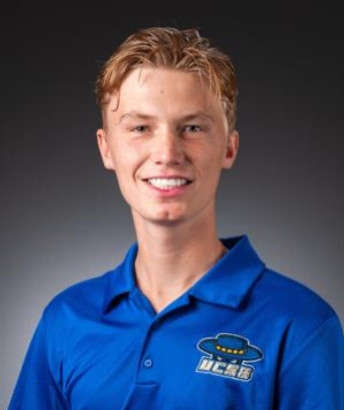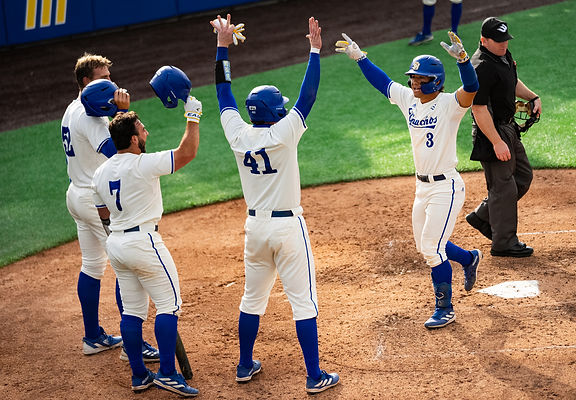
From left to right: Ivan Brethowr, Aaron Parker, Brendan Durfee, and Jessada Brown celebrate a grand slam. (Jeff Liang)
Gauchoball: Sabermetrics at UC Santa Barbara
The UC Santa Barbara Gauchos are at the forefront of sabermetrics in NCAA baseball, enabling them to field a team that is among the most competitive in the nation year in and year out. Meet the leaders of the Gauchos' program and learn the story of Gauchoball, sabermetrics at UCSB.
In 2017, Evan Short, a UCSB student and intern for the Gaucho baseball team, approached head coach Andrew Checketts with a bold assertion, that the team was "missing the boat" by not integrating sabermetric analysis into their daily operations.
Intrigued by the potential benefits of advanced analytical tools for his team, Checketts consulted with friends and colleagues who employed this form of analysis in other athletic conferences throughout the country. They advised him that investing in these upcoming analytical tools would be worthwhile if the funds and team infrastructure were available.
By 2018, he budgeted for the $25,000+ TrackMan tool and assembled UCSB’s first analytics team, with Short leading the charge. “It has been really instrumental,” says Checketts. “If you look at the five years since that first team came together, they have put together the best five-year stretch UCSB has ever had, and it has all been grassroots and student-based.”
In the analytics department’s seventh season, they have become one of the leading teams not just atop their conference, the Big West, but atop the entire nation, with the Gauchos’ on-field success mirroring the success of their analytics department.
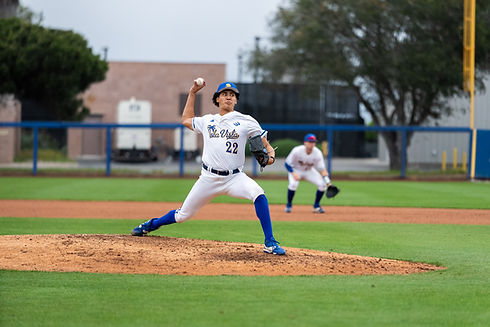
Frank Camarillo fires in a pitch. (Jeff Liang)
The Gauchos qualified for the postseason three years in a row from 2019 to 2022, excluding the season canceled due to the Covid-19 pandemic, in a stretch that also included two Big West titles. During this four year period, the Gauchos compiled a record of 143-47, including 75-19 in the Big West.
In 2024, the Gauchos have once again met, if not exceeded, the championship standard in place since the analytics department spurred the Gauchos’ success six years ago. The Gauchos finished the regular season 42-12, including 26-4 in the Big West, en route to a third Big West title and fourth postseason appearance in the last five seasons, not including the Covid-canceled 2020 season. Additionally, the Gauchos will host a NCAA Regional, the first portion of the NCAA baseball tournament and qualifying round for the College World Series, for the first time since 2015.
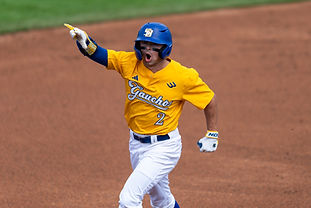
So how do the Gauchos use sabermetrics? How has it led to this period of success at UCSB?
Sabermetrics are integrated into almost every facet of the Gauchos’ baseball operations. Coach Checketts explained that the analytics team not only works on collecting the data, but is heavily involved in the coaching staff’s biggest decisions.
Nick Oakley rounds third base. (Jeff Liang)
“We're utilizing pitch design, pitch development, game management, player recovery, offensive game planning,” Checketts said. “Scouting reports positioning, when we pitch out pitch, pitch sequencing, all of those things are heavily influenced by our analytics team.”
The data provided by the analytics team allows the coaching staff to measure aspects of the game that used to be intangible. “It allows you to quantify things that, in the past, you might not have been able to quantify,” Checketts said.
“So I think there are some things that, as a coach, that you see from experience and instinctually can recognize,” Checketts explained. “[But] the data allows you to really be specific with it, quantify it, and then give accurate and immediate feedback to the players so that they can make adjustments.”
“I think sometimes the data can be just the data, you need to have the coaches to be able to turn the data into usable information and help translate that for the players at times,” Checketts added. “Having the ability to quantify really takes the guesswork out of it.”
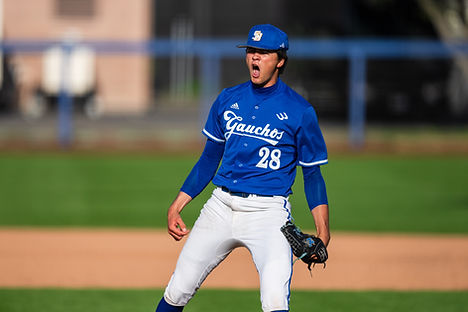
Jackson Flora celebrates finishing a save. (Jeff Liang)
Devon Kost, UCSB Baseball’s Director of Analytics, then elaborated on how his team is able to capture the data they need and turn it into actionable information. “We use a lot of analytics when it comes to pitch design for pitchers. We use a combination of slow motion cameras, Trackman, and pitch logic to help enhance our pitchers’ pitching arsenals.”
One of the Gauchos' top priorities in utilizing sabermetric data is to enhance the fundamentals of both their batters and pitching staff.
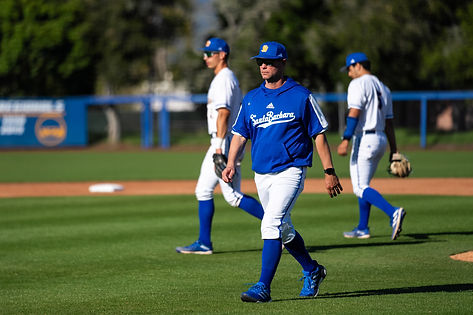
“[We look at] strike zone and in-zone percentage for pitchers,” Checketts said. “We try to not recruit guys that walk people on the mound. That's something that we can control from a recruiting perspective. So if they throw 100 [miles per hour] but don't throw strikes, we’re not interested.”
Beyond just throwing strikes, Checketts and his staff also value some of the deeper insights sabermetrics can provide on pitchers. “Vertical approach angle is something that we value. It's a little bit harder to control because arm slot affects that a little bit,” Checketts said. “We're looking for people that have the ability to have a vertical approach angle, the angle the ball goes into the hitting zone, that is unique and different.”
Andrew Checketts dissolves a mound meeting. (Jeff Liang)
Checketts provided an anecdote to highlight that sabermetrics often need to be understood in context, and that oftentimes one sabermetric can’t illustrate a player’s abilities but rather the sum of all his sabermetrics.
“So Rod Boone, somebody who pitched for us years ago, didn't have a very high spin rate. But because he had it almost directly over-the-top arm slot, and he wasn't super tall, he had a really unique vertical approach angle, and a high vertical break to his fastball. So he would throw 87 mile-per-hour fastballs right down the middle of the plate that would get missed over and over again because of the uniqueness of the profile, even though, at first glance, if you just looked at the spin rates, you would say, ‘Oh, this guy doesn't throw very hard and he's got a slow spinning fastball.’ But some of the other properties to it, a vertical approach, arm slot release, that kind of made it a unicorn heater. So sometimes it's not as simple as just plugging in those basic metrics, it's about putting a couple of them together, seeing if they can do something that you need.”
Kost also described what his department looks for in Gaucho pitchers. “[For] pitchers, it can be the specific movement of their pitches like induced vertical break (IVB) or horizontal break (HB),” Kost said. “We know what type of movements normally play well so we can evaluate how good a pitcher’s arsenal is by using IVB and HB along with a handful of other things.”
“Contact rate… [is] foundational and gets lost, when you're chasing and whiffing, behind exit velocity and launch angle,” Checketts said regarding offensive sabermetrics.

Jonah Sebring fires up the Gauchos' dugout. (Jeff Liang)
“Contact rate and strikeouts to walks. We try to not recruit guys who strike out a lot and don't walk,” Checketts said before adding, “If they hit 110 miles an hour off the bat but can't make contact, we're not interested. Contact rate and then exit velocity, those two things lead to offensive production.”
Checketts expects his players to be savvy in the lexicon of sabermetrics. “We start early in the fall where we want them to know and speak the language,” Checketts said. “We explain to them what the data means [and] what the metrics mean so that they can understand those things so that as we're talking about it in practice, or we're trying to coach them, they have the ability to understand what we're talking about when we get into those numbers.”

Andrew Checketts returns to the Gauchos' dugout after the pregame meeting with the umpires at home plate. (Jeff Liang)
At the same time, Checketts and his staff don’t want their players to become over-reliant on analytics. “We usually won't let them get that in love with it. That's when it starts to become dangerous, it becomes a crutch,” Checketts explained. “There's still some of the instinctual parts of the game. Competitiveness is a foundation. There has to be a level of turning your brain off and executing. Doing and not trying.”
“I think, sometimes, if guys fall in love with the mechanical part of the analytics, they can get too internal with what they're doing and it distracts them from the big picture,” Checketts concluded.
So who is responsible for collecting this crucial data for the coaching staff?
Since Short initiated the analytics department, the role of student lead has transitioned through several hands and is currently held by Kost, a junior at UCSB. Kost leads a team of approximately 15 interns who work to extract data from these tracking devices and transform it into actionable insights for the coaches to enhance their team.
The analytics department is divided into two teams of interns: on-field and research. “Devon has three or four guys who work with him as the on-field analytics team. They handle the day-to-day tasks of setting up machines, pulling data, traveling with us, and attending staff meetings,” Checketts said. “Then there's another group of interns behind the scenes, crunching data and working on projects based on Kost's guidance and the information useful to us.”
The commitment necessary to succeed as a member of UCSB Baseball’s analytics department is full-time. Gamedays are Tuesdays, Fridays, Saturdays, and Sundays. On gamedays, the analytics team can be found distributing scouting reports to coaches and setting up equipment before the game. During the game, the crew operates the equipment and records data. After games, the interns upload video and send hitting and pitching reports to players and coaches. During off days, the department prepares scouting reports for upcoming games and meets every Wednesday to go over the research team’s projects.
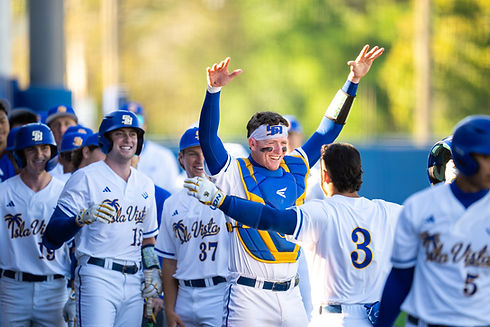
Brendan Durfee (left) embraces Jessada Brown (right). (Jeff Liang)
Checketts knows exactly how his analytics department is able to lead the way in the NCAA. “I think we're really good at turning the data into usable data. I think there's a lot of places that have TrackMan and show it to their recruits, but don't know how to use the data or aren't mining the data,” Checketts said. “I would say five years ago, we were way ahead of the curve. Everybody's kind of catching up now. And so we're trying to stay ahead of the curve the best we can. But I think what we do best with it is utilizing it for player development.”
Kost aims to replicate his success at UCSB at the professional level for a career after graduating. “I have always had a passion for baseball analytics. [I] got in[to UCSB] academically and was told about their baseball analytics department. [I] applied and it progressed from there,” Kost said. “I am pursuing a career in baseball and will hopefully get a job or internship with an MLB team when I graduate.”

